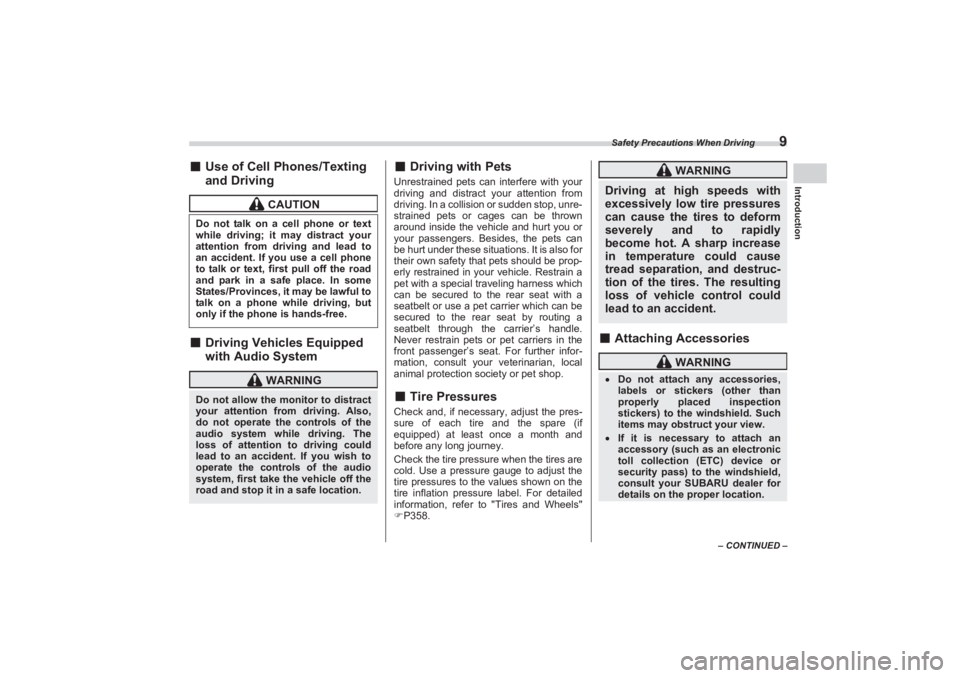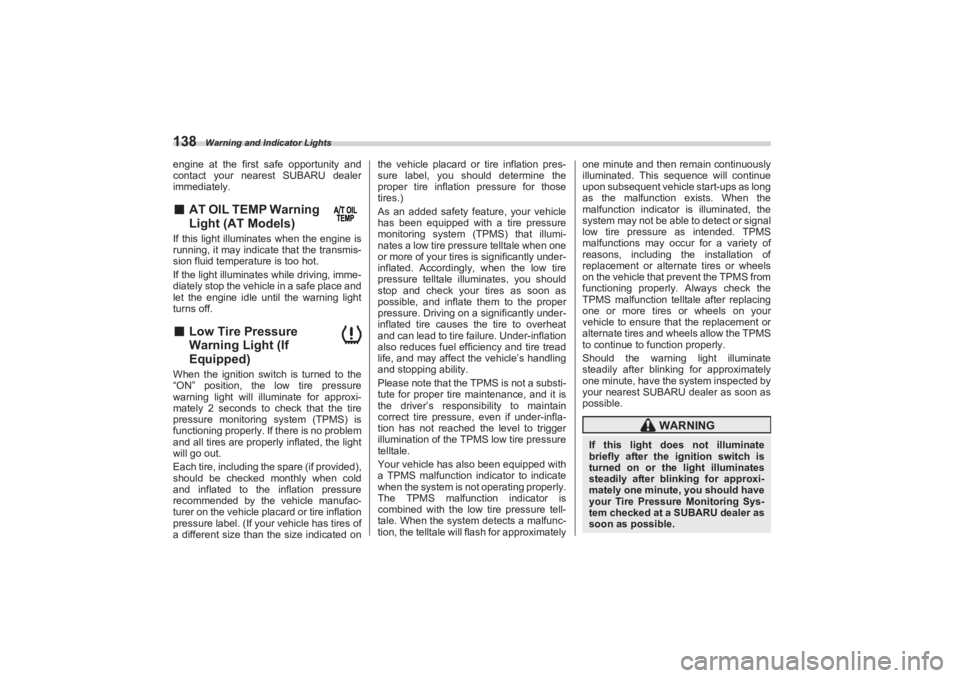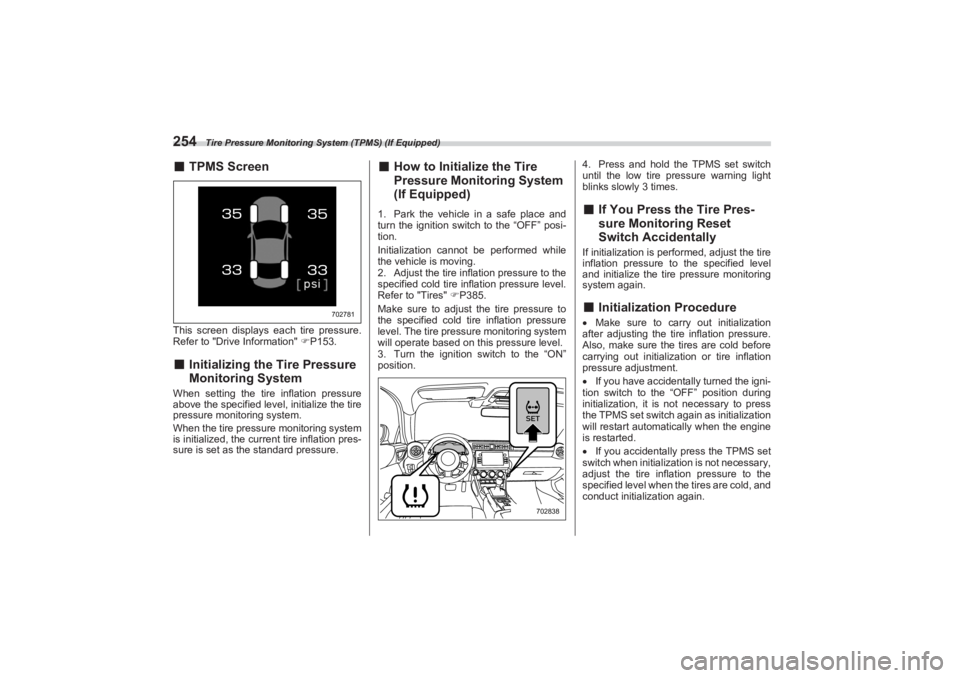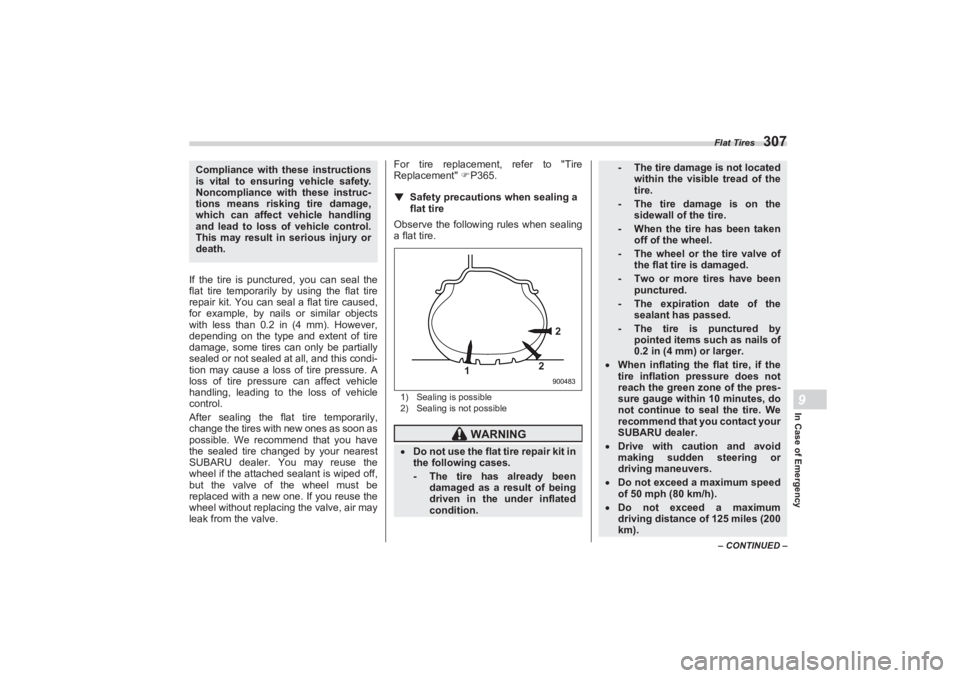2023 SUBARU BRZ inflation pressure
[x] Cancel search: inflation pressurePage 15 of 432

Safety Precautions When Driving
9
Introduction
– CONTINUED –
■Use of Cell Phones/Texting
and Driving■Driving Vehicles Equipped
with Audio System
■Driving with PetsUnrestrained pets can interfere with your
driving and distract your attention from
driving. In a collision or sudden stop, unre-
strained pets or cages can be thrown
around inside the vehicle and hurt you or
your passengers. Besides, the pets can
be hurt under these situations. It is also for
their own safety that pets should be prop-
erly restrained in your vehicle. Restrain a
pet with a special traveling harness which
can be secured to the rear seat with a
seatbelt or use a pet carrier which can be
secured to the rear seat by routing a
seatbelt through the carrier’s handle.
Never restrain pets or pet carriers in the
front passenger’s seat. For further infor-
mation, consult your veterinarian, local
animal protection society or pet shop.■ Tire PressuresCheck and, if necessary, adjust the pres-
sure of each tire and the spare (if
equipped) at least once a month and
before any long journey.
Check the tire pressure when the tires are
cold. Use a pressure gauge to adjust the
tire pressures to the values shown on the
tire inflation pressure label. For detailed
information, refer to "Tires and Wheels"
P358.
■ Attaching Accessories
CAUTION
Do not talk on a cell phone or text
while driving; it may distract your
attention from driving and lead to
an accident. If you use a cell phone
to talk or text, fi rst pull off the road
and park in a safe place. In some
States/Provinces, it may be lawful to
talk on a phone while driving, but
only if the phone is hands-free.
WARNING
Do not allow the monitor to distract
your attention from driving. Also,
do not operate the controls of the
audio system while driving. The
loss of attention to driving could
lead to an accident. If you wish to
operate the controls of the audio
system, first take the vehicle off the
road and stop it in a safe location.
WARNING
Driving at high speeds with
excessively low tire pressures
can cause the tires to deform
severely and to rapidly
become hot. A sharp increase
in temperature could cause
tread separation, and destruc-
tion of the tires. The resulting
loss of vehicle control could
lead to an accident.
WARNING
Do not attach any accessories,
labels or sticke rs (other than
properly placed inspection
stickers) to the windshield. Such
items may obstruct your view. If it is necessary to attach an
accessory (such as an electronic
toll collection (ETC) device or
security pass) to the windshield,
consult your SUBARU dealer for
details on the proper location.
BRZ_U.book 9 ページ 2022年3月29日 火曜日 午後3時59分
Page 144 of 432

Warning and Indicator Lights
138engine at the first safe opportunity and
contact your nearest SUBARU dealer
immediately.■ AT OIL TEMP Warning
Light (AT Models) If this light illuminates when the engine is
running, it may indicate that the transmis-
sion fluid temperature is too hot.
If the light illuminates while driving, imme-
diately stop the vehicle in a safe place and
let the engine idle until the warning light
turns off.■ Low Tire Pressure
Warning Light (If
Equipped)When the ignition switch is turned to the
“ON” position, the low tire pressure
warning light will illuminate for approxi-
mately 2 seconds to check that the tire
pressure monitoring system (TPMS) is
functioning properly. If there is no problem
and all tires are properly inflated, the light
will go out.
Each tire, including the spare (if provided),
should be checked monthly when cold
and inflated to the inflation pressure
recommended by the vehicle manufac-
turer on the vehicle placard or tire inflation
pressure label. (If your vehicle has tires of
a different size than the size indicated on the vehicle placard or tire inflation pres-
sure label, you should determine the
proper tire inflation pressure for those
tires.)
As an added safety feature, your vehicle
has been equipped with a tire pressure
monitoring system (TPMS) that illumi-
nates a low tire pressure telltale when one
or more of your tires is significantly under-
inflated. Accordingly, when the low tire
pressure telltale illuminates, you should
stop and check your tires as soon as
possible, and inflate them to the proper
pressure. Driving on a significantly under-
inflated tire causes the tire to overheat
and can lead to tire failure. Under-inflation
also reduces fuel efficiency and tire tread
life, and may affect the vehicle’s handling
and stopping ability.
Please note that the TP MS is not a substi-
tute for proper tire maintenance, and it is
the driver’s responsibility to maintain
correct tire pressure, even if under-infla-
tion has not reached the level to trigger
illumination of the TPMS low tire pressure
telltale.
Your vehicle has also been equipped with
a TPMS malfunction indicator to indicate
when the system is no t operating properly.
The TPMS malfunction indicator is
combined with the low tire pressure tell-
tale. When the system detects a malfunc-
tion, the telltale will flash for approximately one minute and then remain continuously
illuminated. This sequence will continue
upon subsequent vehicle start-ups as long
as the malfunction exists. When the
malfunction indicator is illuminated, the
system may not be able to detect or signal
low tire pressure as intended. TPMS
malfunctions may occur for a variety of
reasons, including the installation of
replacement or alternate tires or wheels
on the vehicle that prevent the TPMS from
functioning properly. Always check the
TPMS malfunction telltale after replacing
one or more tires or wheels on your
vehicle to ensure that the replacement or
alternate tires and wheels allow the TPMS
to continue to function properly.
Should the warning light illuminate
steadily after blinking for approximately
one minute, have the system inspected by
your nearest SUBARU dealer as soon as
possible.
WARNING
If this light does not illuminate
briefly after the ig nition switch is
turned on or the light illuminates
steadily after blinking for approxi-
mately one minute, you should have
your Tire Pressure Monitoring Sys-
tem checked at a SUBARU dealer as
soon as possible.
BRZ_U.book 138 ページ 2022年3月29日 火曜日 午後3時59分
Page 145 of 432

Warning and Indicator Lights
139
Instruments and Controls3
– CONTINUED –
If this light illuminates while driving,
never brake suddenly. Instead, per-
form the following procedure. Oth-
erwise an accident involving
serious vehicle damage and serious
personal injury could occur.1) Keep driving straight ahead while
gradually reducing speed.2) Slowly pull off the road to a safe
place.If this light still illuminates while
driving after adjusting the tire pres-
sure, a tire may have significant
damage and a fast leak that causes
the tire to lose air rapidly. If you
have a flat tire, replace it with a
spare tire as soon as possible.
When a spare tire is mounted or a
wheel rim is replaced without the
original pressure sensor/transmitter
being transferred, the Low tire pres-
sure warning light will illuminate
steadily after blinking for approxi-
mately one minute. This indicates
the TPMS is unable to monitor all
four road wheels. Contact your
SUBARU dealer as soon as possi-
ble for tire and sensor replacement
and/or system resetting. If the light
illuminates steadily after blinking
for approximately one minute,
promptly contact a SUBARU dealer
to have the system inspected.
CAUTION
The tire pressure monitoring sys-
tem is NOT a substitute for manu-
ally checking tire pressure. The tire
pressure should be checked period-
ically (at least monthly) using a tire
gauge. After any change to tire
pressure(s), the tire pressure moni-
toring system will not re-check tire
inflation pressures until the vehicle
is first driven mo re than 25 mph (40
km/h). After adjusting the tire pres-
sures, increase the vehicle speed to
at least 25 mph (40 km/h) to start the
TPMS re-checking of the tire infla-
tion pressures. If the tire pressures
are now above the severe low pres-
sure threshold, the low tire pres-
sure warning light should turn off a
few minutes later. Therefore, be
sure to install the specified size for
the front and rear tires.
BRZ_U.book 139 ページ 2022年3月29日 火曜日 午後3時59分
Page 258 of 432

Tire Pressure Monitoring System (TPMS) (If Equipped)
252
WARNING
If the low tire pressure warning
light illuminates while driving,
never brake suddenly. Instead,
perform the following procedure.
Otherwise an accident involving
serious vehicle damage and
serious personal injury could
occur.
(1) Keep driving straight ahead
while gradually reducing
speed.(2) Slowly pull off the road to a
safe place.(3) Check the pressure for all
four tires and adjust the pres-
sure to the COLD tire pres-
sure shown on the tire
inflation pressure label on the
center pillar on the driver’s
side.
Even when the vehicle is driven a
very short distance, the tires get
warm and their pressures
increase accordingly. Be sure to
let the tires cool thoroughly
before adjusting their pressures
to the standard values shown on
the tire inflatio n pressure label.
Refer to "Tires and Wheels"
P358. The tire pressure moni-
toring system does not function
when the vehicle is stationary.
After adjusting the tire pressures,
increase the vehicle speed to at
least 25 mph (40 km/h) to start the
TPMS rechecking of the tire infla-
tion pressures. If the tire pres-
sures are now above the severe
low pressure threshold, the low
tire pressure warning light should
turn off a few minutes later.
If this light still illuminates while
driving after adjusting the tire
pressure, a tire may have signifi-
cant damage and a fast leak that
causes the tire to lose air rapidly.
For details, refer to "Flat Tires"
P303.
When a spare tire is mounted or a
wheel rim is replaced without the
original pressure sensor/trans-
mitter being transferred, the low
tire pressure warning light will
illuminate steadily after blinking
for approximately one minute.
This indicates the TPMS is unable
to monitor all fo ur road wheels.
Contact your SUBARU dealer as
soon as possible for tire and
sensor replacement and/or
system resetting.
BRZ_U.book 252 ページ 2022年3月29日 火曜日 午後3時59分
Page 260 of 432

Tire Pressure Monitoring System (TPMS) (If Equipped)
254■TPMS ScreenThis screen displays ea ch tire pressure.
Refer to "Drive Information" P153.■ Initializing the Tire Pressure
Monitoring SystemWhen setting the tire inflation pressure
above the specified level, initialize the tire
pressure monitoring system.
When the tire pressure monitoring system
is initialized, the current tire inflation pres-
sure is set as the standard pressure.
■ How to Initialize the Tire
Pressure Monitoring System
(If Equipped)1. Park the vehicle in a safe place and
turn the ignition switch to the “OFF” posi-
tion.
Initialization cannot be performed while
the vehicle is moving.
2. Adjust the tire infl ation pressure to the
specified cold tire inflation pressure level.
Refer to "Tires" P385.
Make sure to adjust the tire pressure to
the specified cold tire inflation pressure
level. The tire pre ssure monitoring system
will operate based on this pressure level.
3. Turn the ignition switch to the “ON”
position. 4. Press and hold the TPMS set switch
until the low tire pressure warning light
blinks slowly 3 times.
■ If You Press the Tire Pres -
sure Monitoring Reset
Switch AccidentallyIf initialization is perf ormed, adjust the tire
inflation pressure to the specified level
and initialize the tire pressure monitoring
system again.■ Initialization ProcedureMake sure to carry out initialization
after adjusting the tire inflation pressure.
Also, make sure the tires are cold before
carrying out initialization or tire inflation
pressure adjustment.
If you have accidentally turned the igni-
tion switch to the “OFF” position during
initialization, it is not necessary to press
the TPMS set switch again as initialization
will restart automatically when the engine
is restarted.
If you accidentally press the TPMS set
switch when initialization is not necessary,
adjust the tire inflation pressure to the
specified level when the tires are cold, and
conduct initialization again.
702781
702838
BRZ_U.book 254 ページ 2022年3月29日 火曜日 午後3時59分
Page 261 of 432

Parking Your Vehicle
255
Starting and Operating7
– CONTINUED –
■When Initialization of the Tire
Pressure Monitoring System
has FailedInitialization can be completed in a few
minutes. However, in the following case,
the settings have not been recorded and
the system will not o perate properly. If
repeated attempts to record tire inflation
pressure settings ar e unsuccessful, have
the vehicle checked at your SUBARU
dealer.
When operating the TPMS set switch,
low tire pressure warning light does not
blink 3 times.
After carrying out the initialization
procedure, the low tire pressure warning
light blinks for 1 minute then stays on after
driving for 20 minutes.
■ Registering ID CodesEvery tire pressure warning valve and
transmitter has a unique ID code. In addi-
tion to the set of tire pressure monitoring
system sensor ID code s initially registered
to the vehicle, a second set of ID codes
can be registered.
A second set of tire pressure monitoring
system sensor ID codes can be registered
at your SUBARU dealer. When 2 sets of
ID codes have been registered, either ID
code set can be selected.■ Changing the ID code set1. Park the vehicle in a safe place and
turn the ignition swit ch to the “ON” posi-
tion.
2. Press the TPMS set switch 3 times
within 3 seconds.
3. The low tire pressure warning light will
illuminate for 3 seconds and then blink 3
times.
4. The low tire pressure warning light will
blink for 1 minute and then illuminate.
5. When the ID code change has
completed, the tire pressure monitoring
light will turn off.
Check that tire pressures are displayed on
the TPMS screen.
7-16. Parking Your Vehicle■ Parking BrakeTo set the parking brake, depress the
brake pedal firmly and hold it down until
the parking brake lever is fully pulled up.
WARNING
Do not operate the TPMS set switch
without first adjust ing the tire infla-
tion pressure to the specified level.
Otherwise, the low tire pressure
warning light may not come on even
if the tire inflation pressure is low,
or it may come on when the tire
inflation pressure is actually nor-
mal.
WARNING
Never leave unattended children
or pets in the vehicle. They could
accidentally injure themselves or
others through inadvertent oper-
ation of the vehicle. Also, on hot
or sunny days, the temperature in
a closed vehicle could quickly
become high enough to cause
severe or possibly fatal injuries to
people. Do not park the vehicle over flam-
mable materials such as dry
grass, waste paper or rags, as
they may burn easily if they come
near hot engine or exhaust
system parts. Be sure to stop the engine if you
take a nap in the vehicle. If engine
exhaust gas enters the passenger
compartment, occupants in the
vehicle could die from carbon
monoxide (CO) contained in the
exhaust gas.
BRZ_U.book 255 ページ 2022年3月29日 火曜日 午後3時59分
Page 296 of 432

New Vehicle Break-In Driving – the First 1,000 miles (1,600 km)
2908-1. New Vehicle Break-In
Driving – the First 1,000 miles (1,600 km)The performance and long life of your
vehicle are dependent on how you handle
and care for your vehicle while it is new.
Follow these instructions during the first
1,000 miles (1,600 km):
Do not race the engine. And do not
allow engine speed to exceed 4,000 rpm
except in an emergency.
Do not drive at one constant engine or
vehicle speed for a long time, either fast or
slow.
Avoid starting suddenly and rapid
acceleration, except in an emergency.
Avoid hard braking, except in an emer-
gency.
The same break-in procedures should be
applied to a newly installed or overhauled
engine or when brake pads are replaced
with new ones.
8-2. Fuel Economy HintsThe following suggestions will help to
save your fuel.
Select the proper gear position for the
speed and road conditions.
Avoid sudden acceleration or decelera-
tion. Always accelerate gently until you
reach the desired speed. Then try to main-
tain that speed for as long as possible.
Do not pump the accelerator and avoid
racing the engine.
Avoid unnecessary engine idling.
Keep the engine properly tuned.
Keep the tires inflated to the correct
pressure shown on the tire inflation pres-
sure label, which is located on the driver’s
center pillar. Low pressure will increase
tire wear and fuel consumption.
Use the air conditioner only when
necessary.
Keep the front and rear wheels in
proper alignment.
Avoid carrying unnecessary luggage or
cargo.
8-3. Engine Exhaust Gas (Carbon Monoxide)
WARNING
Never inhale engine exhaust gas.
Engine exhaust gas contains
carbon monoxide, a colorless
and odorless gas which is
dangerous, or even lethal, if
inhaled. Always properly maintain the
engine exhaust system to prevent
engine exhaust gas from entering
the vehicle. Never run the engine in a closed
space, such as a garage, except
for the brief time needed to drive
the vehicle in or out of it. Avoid remaining in a parked
vehicle for a long time while the
engine is running. If that is
unavoidable, then use the ventila-
tion fan to force fresh air into the
vehicle. Always keep the front ventilator
inlet grille free from snow, leaves
or other obstructions to ensure
that the ventilation system
always works properly.
BRZ_U.book 290 ページ 2022年3月29日 火曜日 午後3時59分
Page 313 of 432

Flat Tires
307
In Case of Emergency9
– CONTINUED –
If the tire is punctured, you can seal the
flat tire temporarily by using the flat tire
repair kit. You can seal a flat tire caused,
for example, by nails or similar objects
with less than 0.2 in (4 mm). However,
depending on the type and extent of tire
damage, some tires can only be partially
sealed or not sealed at all, and this condi-
tion may cause a loss of tire pressure. A
loss of tire pressure can affect vehicle
handling, leading to the loss of vehicle
control.
After sealing the flat tire temporarily,
change the tires with new ones as soon as
possible. We recommend that you have
the sealed tire changed by your nearest
SUBARU dealer. You may reuse the
wheel if the attached sealant is wiped off,
but the valve of the wheel must be
replaced with a new one. If you reuse the
wheel without replacing the valve, air may
leak from the valve. For tire replacement, refer to "Tire
Replacement" P365.
▼ Safety precautions when sealing a
flat tireObserve the following rules when sealing
a flat tire.1) Sealing is possible
2) Sealing is not possible
Compliance with these instructions
is vital to ensuring vehicle safety.
Noncompliance with these instruc-
tions means risking tire damage,
which can affect vehicle handling
and lead to loss of vehicle control.
This may result in serious injury or
death.
WARNING
Do not use the flat tire repair kit in
the following cases.
- The tire has already been
damaged as a result of being
driven in the under inflated
condition.
900483
1 2
2
- The tire damage is not located
within the visible tread of the
tire.- The tire damage is on the
sidewall of the tire.- When the tire has been taken
off of the wheel.- The wheel or the tire valve of
the flat tire is damaged.- Two or more tires have been
punctured.- The expiration date of the
sealant has passed.- The tire is punctured by
pointed items such as nails of
0.2 in (4 mm) or larger.
When inflating the flat tire, if the
tire inflation pressure does not
reach the green zone of the pres-
sure gauge within 10 minutes, do
not continue to seal the tire. We
recommend that you contact your
SUBARU dealer. Drive with caution and avoid
making sudden steering or
driving maneuvers. Do not exceed a maximum speed
of 50 mph (80 km/h). Do not exceed a maximum
driving distance of 125 miles (200
km).
BRZ_U.book 307 ページ 2022年3月29日 火曜日 午後3時59分